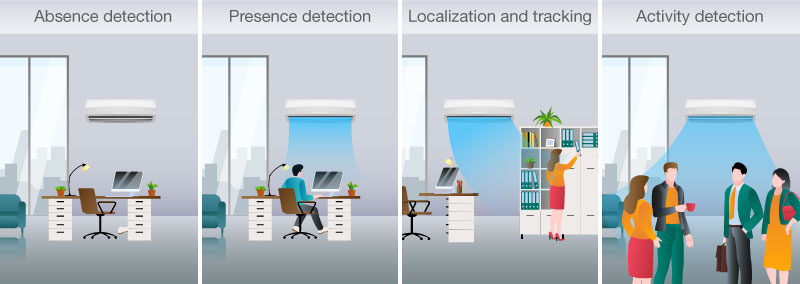SSZT283 july 2020 IWR6843
More than ever, as people in both developed and developing countries rely on air conditioners (ACs) for a comfortable living space, there’s been a rapid increase in energy consumption.
According to “The Future of Cooling,” a report from the International Energy Association, ACs account for 10% of the total energy consumed today.This usage is expected to triple by 2050, which is equivalent to the current combined electricity capacity of the United States, European Union and Japan. The number of ACs in residential and commercial buildings globally will grow to 5.6 billion by 2050, compared to 1.6 billion today. This amounts to 10 new ACs sold every second for the next 30 years.
The role of occupancy sensing with ACs
Human occupancy sensing can make ACs smarter and more energy-efficient by adapting to in-room activity levels and directing airflow where it’s needed most. Figure 1 illustrates a few scenarios where feedback from occupancy sensing like presence/absence, activity and people position detection helps conserve energy and makes environments more comfortable by modulating room temperatures and directing airflow toward room occupants.
 Figure 1 Scenarios depicting how feedback gained from occupancy sensing determines AC usage
Figure 1 Scenarios depicting how feedback gained from occupancy sensing determines AC usagePassive infrared sensors and camera solutions are two technologies used in AC occupancy sensing. Passive infrared sensors are low cost and consume little power, but have higher false-detection issues in bright daylight and lack sensitivity to fine motion. In contrast, cameras offer the highest resolution available, but have the potential for higher instances of false detection, particularly with shadows and pictures of humans.
While occupancy sensing is being adopted to achieve energy savings, the industry is moving towards making ACs more intelligent with edge processing. Apart from controlling the AC operation for user comfort with presence detection, the movement towards a single sensing technology is ongoing. In the future, ACs will integrate additional features for user safety monitoring such as fall event detection and vital sign monitoring, including heart rate and breathing rate.
Advantages of millimeter-wave sensors for occupancy sensing
TI millimeter-wave (mmWave) sensors provide a rich data set with precise range, velocity and direction of arrival information for each object in the area of interest. With a digital signal processor (DSP) performing object detection, classification and tracking, it becomes possible to derive people occupancy information such as presence, absence, count and the precise position of people relative to an AC unit. The AC unit can use this information to make intelligent decisions; for example, when a person enters the room, the sensor tracks the presence of that person for a minimum preset duration before turning on. If they remain in the room, using tracking/localization information, the AC can direct airflow to that person for comfort. Based on the number of people in the room, the temperature of the AC will adjust accordingly for maximum comfort and energy savings.
- Reduced false detection.
- The ability to function in harsh environments.
- Aesthetically pleasing product designs and small sensor sizes.
- Reduced privacy concerns due to sensing technology instead of camera use.
Enabling intelligence at the edge
TI mmWave 60-GHz sensors integrate a frequency-modulated continuous wave transceiver, an on-chip monitoring and calibration mechanism, an Arm® Cortex®-R4F microcontroller, and C674x DSP on a single chip. This integration enables intelligence on a highly integrated sensor with real-time data processing on the device itself.
In the near future, ACs will become entirely self-reliant, data-based systems with no need for remotes or human interaction through an AC control unit. The sensing technology in ACs will constantly gather data to optimize comfort. For example, over time in an office setting, the sensor will determine that the highest amount of people are in office from 9 AM to 5 PM. Based on this data, the system will learn to direct more air during busier times and limit or turn off airflow during non-peak times, leading to less energy consumption which will save the business money.
As demand for residential and commercial ACs continues, tripling by 2050, occupancy sensing using mmWave technology may reduce overall AC energy consumption by as much as 35%. As we move to the future, mmWave technology will continue to have a greater impact on not only the way that HVAC systems operate, but the reduction of overall emissions into our environment.
Additional resources